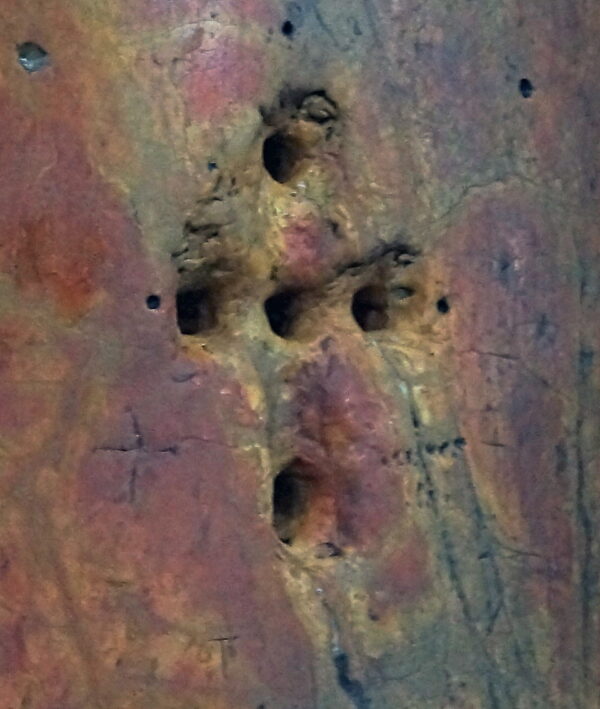In the Church of the Nativity in Bethlehem, built over the cave where Jesus was born, there is also an arresting reminder of His death.
 The nave of the church is lined with red limestone pillars that were quarried just outside the town in the sixth century. One of them bears a figure of five holes in the form of a cross. I had difficulty taking this picture of the five-fingerhole cross because so many people continually crowd around it, trying to fit the fingers of one hand into the cruciform holes. No one knows who made these holes or how this custom began. But it illustrates the desire we all have to touch something of Jesus—if only the hem of His garment.
The nave of the church is lined with red limestone pillars that were quarried just outside the town in the sixth century. One of them bears a figure of five holes in the form of a cross. I had difficulty taking this picture of the five-fingerhole cross because so many people continually crowd around it, trying to fit the fingers of one hand into the cruciform holes. No one knows who made these holes or how this custom began. But it illustrates the desire we all have to touch something of Jesus—if only the hem of His garment.
This is the reason for what Christians call the sacraments, which are ways of touching God and being touched by Him, of physically experiencing His presence. No sacraments are purely mental or mystical; all involve physical means, from the water of baptism to the bread and wine of the eucharist. In the words of André Dubus, “My belief in the sacrament of the eucharist is simple: without touch, God is a monologue, an idea, a philosophy.”
Touching God, however, is not confined to the two formal Protestant sacraments, nor even to the seven recognized by the Roman Catholic church (Baptism, Holy Communion, Confirmation, Reconcilation, Marriage, Ordination, Anointing of the Sick). God has created a whole world brimming with vibrant physical sensations, and He gave us bodies with five keen and thirsty senses, in order that we might constantly interact with Him physically. The merely spiritual is not sufficient; if love is to be real, to be consummated, we need total bodily involvement.
One year in the week before Easter, I recall watching the magnolia tree in our backyard, marveling at the gradual eruption of enormous pink blossoms. Where did it come from, all this beauty and color and glory? It was as if I were seeing the emergence of flowers for the first time.
Another year I awoke on Easter morning to a dream of being by the seashore, where all of nature looked so wonderfully pure, so obviously created by the good and loving God. That dream stayed with me for weeks afterwards; indeed I recall it to this day. So simple, yet its beauty and purity continue to flow into my waking life and my prayers, propelling my spirit to praise. My Easter gift!
Touch, sight, hearing, smell, taste: the five senses. And Jesus bore five wounds, reflected in the five holes of the Bethlehem cross. Like the Apostle Thomas, pilgrims to the Church of the Nativity desire to touch these wounds, to place their fingers in the holes of Jesus’ hands and feet and side—not because we doubt that Christ is truly risen, for this was not Thomas’s basic problem. Rather, I suspect Thomas had trouble believing that the risen Christ was a real man with flesh and blood, and more than that, real wounds. For we too are wounded, and it amazes us that God Himself might share our woundedness, that He might have a real body capable of being pierced, susceptible to bleeding and dying.
Here we enter into an order of mystery that cannot simply be formulated into theology. It has to be physically touched. Here is the meeting place of heaven and earth. “Taste and see that the Lord is good” (Ps 34:8).
Put your finger here; see My hands. Reach out your hand and put it into My side. Stop doubting and believe! ~John 20:27
(The above is a modified version of Chapter 50 in my book Jesus: His Story In Stone.)
Next Post: Flying, Falling, Catching: A New Henri Nouwen Book!




